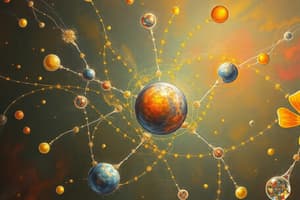Podcast
Questions and Answers
What is the smallest particle of an element that can exist?
What is the smallest particle of an element that can exist?
- Atom (correct)
- Molecule
- Electron
- Ion
Which of the following statements is true regarding the mass of electrons compared to protons or neutrons?
Which of the following statements is true regarding the mass of electrons compared to protons or neutrons?
- Electrons have the same mass as neutrons.
- Electrons are heavier than protons.
- Electrons have negligible mass compared to protons. (correct)
- Electrons and protons have equal mass.
In the symbolic representation of a nuclide, what does the letter 'Z' represent?
In the symbolic representation of a nuclide, what does the letter 'Z' represent?
- Number of neutrons
- Mass number
- Atomic number (correct)
- Chemical symbol
Which particle has a positive electric charge?
Which particle has a positive electric charge?
What is the relationship between mass number (A), atomic number (Z), and number of neutrons (N) in a nuclide?
What is the relationship between mass number (A), atomic number (Z), and number of neutrons (N) in a nuclide?
Flashcards are hidden until you start studying
Study Notes
The Atom
- An atom is the smallest unit of an element that can exist.
- Atoms are made up of three main types of subatomic particles: protons, neutrons and electrons.
- Protons have a positive charge, neutrons have no charge and electrons have a negative charge.
- Protons and neutrons are found in the nucleus of an atom, while electrons orbit the nucleus.
- The mass of a proton and a neutron are approximately equal, and both are about 1833 times more massive than an electron.
- The atomic number (Z) of an element is the number of protons in the nucleus of an atom of that element.
- The mass number (A) of an element is the total number of protons and neutrons in the nucleus of an atom of that element.
- The number of neutrons in the nucleus is represented by the symbol N, calculated by subtracting the atomic number (Z) from the mass number (A).
- Atoms can be represented using the following symbolic notation: AZX.
- Where A represents the mass number, Z represents the atomic number and X is the chemical symbol of the element.
Studying That Suits You
Use AI to generate personalized quizzes and flashcards to suit your learning preferences.




